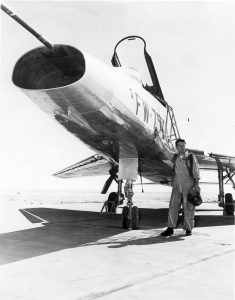29 October 1953: Lieutenant Colonel Frank Kendall (“Pete”) Everest, United States Air Force, flew a new prototype air superiority fighter, North American Aviation’s YF-100A Super Sabre, serial number 52-5754, over the 3 kilometer and 15-kilometer courses at the Salton Sea, in the Colorado Desert of southeastern California.
Flying four runs over the short course, Everest averaged 757.75 miles per hour (1,219.48 kilometers per hour). Although this was 4.80 miles per hour (7.725 kilometers per hour) faster than the FAI record set three weeks earlier by Lieutenant Commander James B. Verdin, U.S. Navy, with a Douglas XA4D-1 Skyray,¹ it was not fast enough to establish a new world record under FAI rules, which required that a new record exceed the previous record by 1%.
Next came four speed runs over the 15/25 kilometer course. All runs were made with the Super Sabre flying within 100 feet (30 meters) of the ground. The official Fédération Aéronautique Internationale (FAI) average speed was 1,215.298 kilometers per hour (755.151 miles per hour)—0.99 Mach. ²
The course at the Salton Sea was used because its surface lies 235 feet (72 meters) below Sea Level. The denser air causes undesired transonic effects to occur at lower speeds, but the higher air temperatures help to delay them, allowing the pilot a greater margin of control during the speed record runs.
At Edwards, Pete Everest was involved in nearly every flight test program, flying the F-88, F-92, F-100, F-101, F-102, F-104 and F-105 fighters, the XB-51, YB-52, B-57 and B-66 bombers. He also flew the pure research aircraft, the “X planes:” the X-1, X-1B, X-2, X-3, X-4 and X-5. Pete Everest flew the X-1B to Mach 2.3, and he set a world speed record with the X-2 at Mach 2.9 (1,957 miles per hour, 3,149.5 kilometers per hour) which earned him the title, “The Fastest Man Alive.” He was the test pilot on thirteen of the twenty X-2 flights.
In 1957, Lieutenant Colonel Everest was awarded the Harmon Trophy “for the most outstanding international achievements in the arts and/or science of aeronautics for the preceding year,” and also received the Octave Chanute Award “for an outstanding contribution made by a pilot to the art, science and technology of aeronautics.” (1)
(1) Source: ThisDayinAviation by Bryan R. Swopes
